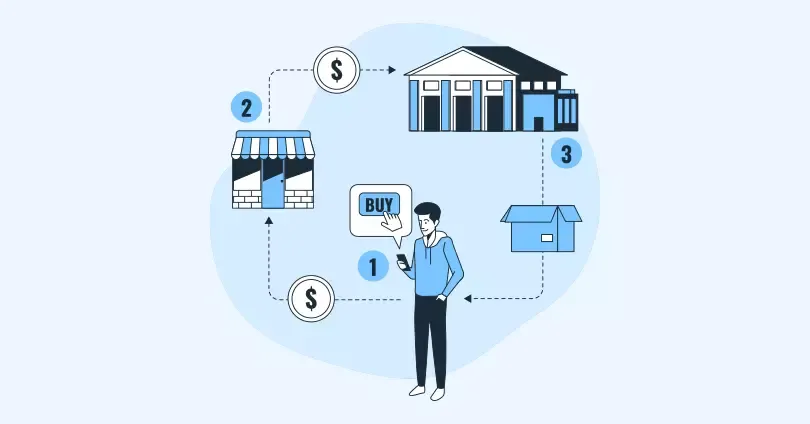Dropship Inventory Management: How to Keep Your Business Running Smoothly.

Dropshipping has become an increasingly popular business model in recent years, allowing entrepreneurs to start their own online store without the need for inventory. However, while dropshipping eliminates the need for physical inventory, it doesn't eliminate the need for effective inventory management.
In fact, dropship inventory management is a critical aspect of running a successful dropshipping business. In this blog, we'll discuss some tips and strategies for effective dropship inventory management.

The success of your dropshipping business largely depends on the reliability of your suppliers. Choose suppliers who are reputable, have a good track record, and provide accurate inventory data. Look for suppliers who offer real-time inventory tracking and automated updates to your store, ensuring that your customers always have access to the most up-to-date product information.
Set Realistic Expectations
When it comes to inventory management in a dropshipping business, setting realistic expectations is key. Don't promise customers products that are out of stock or that you can't guarantee will arrive on time. Be transparent about shipping times and product availability, and communicate any delays or issues as soon as possible.
Use Inventory Management Software
Investing in inventory management software can help streamline your dropship inventory management process. Inventory management software can automate inventory tracking, provide real-time inventory data, and help you make informed decisions about stock levels and ordering.
Keeping track of inventory levels is crucial to ensure that you always have products in stock and ready to ship. Monitor inventory levels regularly and set up automatic notifications when stock levels reach a certain threshold. This will help you avoid stockouts and backorders, which can lead to unhappy customers and lost sales.
Analyze Sales Data
Analyzing sales data can help you make informed decisions about your inventory management strategy. Look at your sales data to determine which products are selling well and which are not. Use this information to adjust your inventory levels and ordering strategy accordingly.
Effective dropship inventory management is essential for success. Reliable suppliers, realistic expectations, software, monitoring levels, and analyzing data help keep your business running smoothly.
Conclusion
Effective inventory management is key to dropshipping success. By following the tips in this blog, dropshippers can ensure timely deliveries, build customer loyalty, and increase profitability.
Here are some of the tips discussed in the blog:
- Choose reliable suppliers
- Set realistic expectations
- Use inventory management software
- Monitor inventory levels
- Analyze sales data
FAQs
Dropshipping is a retail fulfillment method where the seller doesn't keep the products it sells in stock. Instead, when an order is placed, the seller purchases the item from a third party—usually a wholesaler or manufacturer—and has it shipped directly to the customer.
What are the benefits of dropshipping?
There are many benefits to dropshipping, including:
- No need to carry inventory: As a dropshipper, you don't need to purchase or store any inventory. This can save you a significant amount of money on warehouse space, rent, and inventory management costs.
- Low startup costs: Dropshipping is a low-cost business model, making it a great option for entrepreneurs with limited capital.
- Global reach: You can dropship products from anywhere in the world, giving you access to a global market.
- Easy to scale: Dropshipping is a scalable business model, so you can easily increase your sales as your business grows.
What are the challenges of dropshipping?
There are a few challenges associated with dropshipping, including:
- Product availability: Not all products are available for dropshipping. You'll need to find suppliers that offer the products you want to sell.
- Shipping times: Shipping times can vary depending on the supplier you use. This can be a challenge if you're selling products that need to be delivered quickly.
- Customer service: As a dropshipper, you're responsible for providing customer service for any issues that arise with orders. This can be a challenge if you're not familiar with the products you're selling.
How do I choose a dropshipping supplier?
When choosing a dropshipping supplier, there are a few factors you'll need to consider, including:
- Product selection: Make sure the supplier has a wide selection of products that you're interested in selling.
- Inventory levels: Make sure the supplier has a good inventory turnover rate. This will help to ensure that you don't run out of stock on popular products.
- Shipping times: Make sure the supplier has fast and reliable shipping times. This will help to ensure that your customers are happy with their experience.
- Customer service: Make sure the supplier has good customer service. This will help to resolve any issues that arise with orders.
How do I set up dropshipping inventory management?
There are a few different ways to set up dropshipping inventory management. One option is to use a dropshipping inventory management software program. These programs can help you to track inventory levels, set up reorder alerts, and more. Another option is to set up a spreadsheet to track inventory levels. This is a more manual process, but it can be effective if you have a small number of products.
How do I track dropshipping inventory levels?
It's important to track your dropshipping inventory levels closely so that you can avoid running out of stock. You can track your inventory levels manually or using a dropshipping inventory management software program.
How do I set up reorder alerts?
Reorder alerts can help you to avoid running out of stock. When you set up a reorder alert, you'll be notified when your inventory levels get low. This will give you time to order more products before you run out of stock.
What are some dropshipping inventory management tips?
Here are a few dropshipping inventory management tips:
- Use a dropshipping inventory management software program.
- Track your inventory levels closely.
- Set up reorder alerts.
- Work with reliable suppliers.
- Have a backup plan in case of stock outages.
What are some common dropshipping inventory management mistakes?
Here are a few common dropshipping inventory management mistakes:
- Not tracking inventory levels closely.
- Not setting up reorder alerts.
- Working with unreliable suppliers.
- Not having a backup plan in case of stock outages.
What are the future trends in dropshipping inventory management?
The future trends in dropshipping inventory management include:
- The use of artificial intelligence (AI) to automate inventory management tasks.
- The use of blockchain technology to track inventory levels and transactions.
- The development of new dropshipping inventory management software programs.




